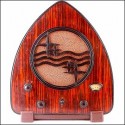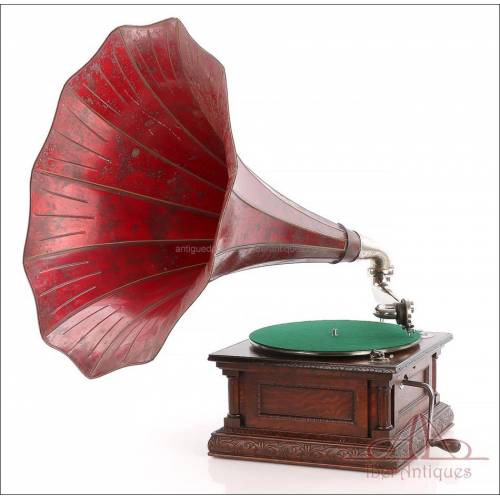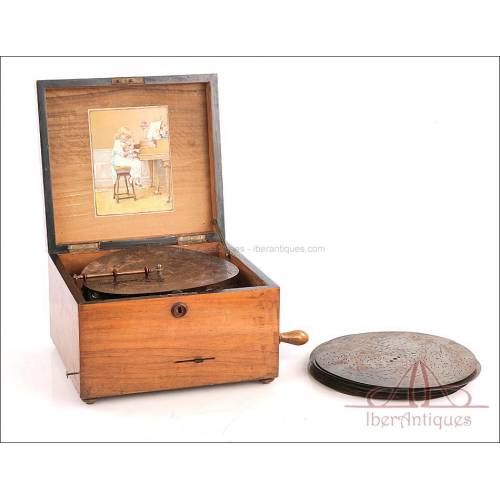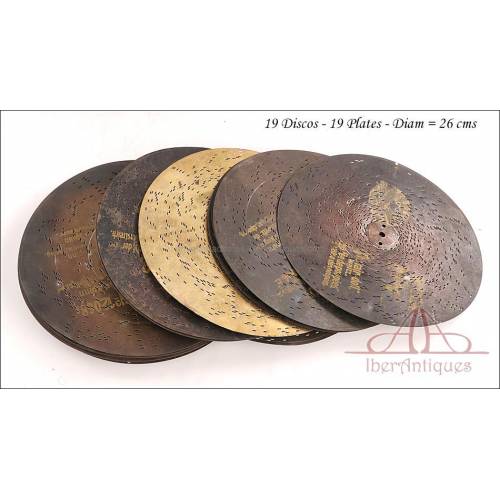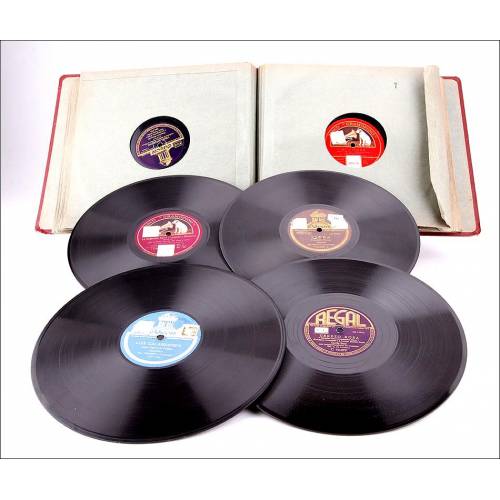Antique Musical Devices
Imagine what the world would be like without music. Terrible, no doubt. And yet, not so long ago it was impossible for most people to listen to music at will, whenever they felt like it or needed it. Until the advent of inventions like the radio or the phonograph, there was no way to listen to music unless it was played live. Folk songs were tra...
Imagine what the world would be like without music. Terrible, no doubt. And yet, not so long ago it was impossible for most people to listen to music at will, whenever they felt like it or needed it. Until the advent of inventions like the radio or the phonograph, there was no way to listen to music unless it was played live. Folk songs were transmitted orally, from fathers and mothers to sons and daughters; music was heard at village festivals, or perhaps in church... On the other hand, "cultured" music was reserved for the upper classes, who could afford to hire chamber orchestras or attend operatic or musical performances.
It was a world without radio or television; without record players, cassettes or CD players. And of course, without Spotify, iTunes, YouTube or streaming music. Something incredible. And yet, the passion that we human beings feel for music managed that the compositions remained in time and continued to be listened to. It could be in the royal parlor or during the Midnight Mass; at the Paris Opera, or in the bandstand of a small village in La Mancha... In the families there was always someone who knew how to play an instrument, or who was even part of the village band. Thus, music managed to reach all corners and was considered a real luxury, a real pleasure.
The first devices that managed to bring the "mechanical" music to all corners were the old music boxes. The first recorded ones date back to the 16th century and were made by Swiss watchmakers. The first models consisted of metal discs, which were replaced by cylinders at the beginning of the 18th century. The evolution of music boxes gave rise to mechanical pianos, pianolas and barrel organs. These devices were commonly used in taverns, parties and popular gatherings, as substitutes for bands and orchestras.
The appearance of musical devices (the famous "talking machines") in the late nineteenth century marked a before and after. Thanks to Edison's phonograph, first; and Marconi's radio, a little later, homes were filled with the wonderful sounds that make up a melody. Phonographs and gramophones made it possible to listen to favorite pieces over and over again, while the radio brought the latest musical news into homes. The evolution of these devices, whose manufacturers advertised with slogans like "Put an orchestra in your house" was dizzying: simpler, better-sounding and more affordable designs were emerging all the time.
The 60s and 70s saw the appearance of new design turntables (those nostalgic pick-ups...),made of plastic, methacrylate, wood, aluminium... Wonderful musical devices that today awaken our fascination, and that collectors seek at auctions, online stores and second-hand flea markets. In the form of portable models or complete furniture, they served to bring the liveliest music to the nightclubs of the time.
Years later and already in the XXI century, turntables again arouse interest and major brands launch models that reproduce the unique sound of the needle on vinyl. But reality rules, and today computer applications are triumphant: music reaches every corner of the planet. However, the beauty of the trumpet gramophones of the beginning of the century, of the tube radios and of the turntables of decades ago is still intact. They bear witness to a revolutionary era that brought music into our lives, and this makes them worthy of our heartfelt tribute.
Subcategories
Antique Gramophones
Antique gramophones are spectacular musical devices, imposing and attractive. Their aesthetics of the first half of the 20th century, their beautiful designs and their nostalgic sound have turned them into highly sought-after pieces by collectors. They not only stand out for their impressive presence: they also allow you to enjoy the sound of the old slate records. The antique gramophones that are part of our collections were manufactured between the end of the 19th century and the middle of the 20th century (1955): they are collector's items that are still in good working order today. Among them are iconic models, marketed by the best brands of all times: from His Master's Voice, to Odeon; from Columbia, to Pathé.
Antique jukeboxes are often confused with antique gramophones and identified as such. In reality, jukeboxes are gramophones without an external horn or trumpet. Under this generic name are also included those nostalgic machines that allowed to listen to music in bars, after inserting some coins. Antique gramophones, on the other hand, include all kinds of models: from the magnificent horn or trumpet designs to the practical suitcase or travel gramophones. And not forgetting, of course, the elegant mantel gramophones.History of antique gramophones
The origin of musical recordings dates back to the first phonographs. Before these devices, an important evolution was assumed: instead of recording sounds on a cylinder, the recording was made on a flat disc. The first was patented in 1887 by Emile Beriner, to whom we also owe the invention of vinyl records. Its design included the classic elements common to all old gramophones: a crank motor (mechanical), a needle with a reproducer, a turntable and a speaker in the form of a horn or trumpet. Although there are dissenting voices on the matter, it is believed that Berliner founded the Victor Talking Machine Company together with Eldridge L. Johnson. This company entered in "commercial war" with Edison and his phonographs, although around 1910 the gramophone definitively displaced the phonograph. From then on and until the arrival of electric record players, its rise and popularity were unstoppable.Types of antique gramophones
.
Trumpet or horn. The first ones that appeared in the market. Their impressive image and good sound has turned them into authentic jewels. To make them work you have to operate the crank; the motor, then, will rotate the plate. Through the reproducer, the sound coming from the contact between the needle and the slate disc reaches the trumpet, which amplifies the sound.
Mantel. Its operation is similar to that of the trumpet gramophones, although in this case the speaker is located under the plate. They do not have a trumpet, which makes them lighter and more functional. They began to be marketed from 1910.
/>Suitcase. Suitcase. Also known as portable, travel or even "picnic" gramophones. They began to be manufactured in 1910 and became very popular. Its parts (reproducer and crank) were guarded disassembled inside a suitcase itself, in whose lower part were the plate and the motor. The loudspeaker, meanwhile, occupied the lid, where there was also usually a compartment to store records.Marks of antique gramophones. Icons of the nineteenth and twentieth centuries
.
Antique gramophones were manufactured and marketed by famous record labels, some of which have survived to the present day (often merged with each other and under other names). The first known record company was the Victor Talking Machine Co. founded in 1901 by Eldridge L. Johnson; in 1930 it was sold to RCA and became known as RCA Victor. Other famous brands of the time were Columbia, Odeon, the French Pathé... However, the best known of all is undoubtedly His Master's Voice (His Master's Voice in the original). At first, this brand and its famous logo with the dog Nipper listening to a gramophone were owned by The Gramophone & Typewriter Company. In 1901 the North American rights became property of the Victor Talking Machine Co.; however, in the Commonwhealt countries it remained property of The Gramophone & Typewriter Co. From 1909, this company became known under the name of the title of the picture, 'His Master's Voice' (HMV).
Antique gramophones are nowadays perfect pieces to decorate any living room with style and personality. Music and vintage antiques lovers will find in our collections the most interesting and sought after models.Antique Phonographs
Antique phonographs were the first musical devices capable of reproducing sounds, previously recorded on wax cylinders. Their mechanism is very simple, but at the same time very resistant. Thanks to this feature, today there are phonographs more than 100 years old that are able to reproduce melodies recorded on vintage cylinders. The antique phonographs in our collection have been manufactured by the best brands of all times, including emblematic firms such as Edison or Columbia. These devices were manufactured from 1890 until 1920, when they were definitively replaced by gramophones.
History of early phonographs
The first phonograph in history was designed and built by Thomas A. Edison in 1877. It was undoubtedly one of the most important inventions of the 19th century: for the first time in history it was possible to record and reproduce sounds, from the human voice to the most complex musical performances. Initially, the first devices were not used to reproduce music, but to facilitate dictation work in offices. The first cylinders were made of metal, and the needle recorded the sounds directly on the foil; however, Alexander Graham Bell's laboratory developed more practical, cheaper and lighter wax-coated cardboard cylinders, which definitively replaced the metal ones. In 1888 the first gramophone was launched, and for 30 years both inventions coexisted and fought for the record market of the time. In the 1920s, gramophones definitively displaced the old phonographs; however, for a while the Edison firm continued to market a version called "dictaphone". This device was used in offices to record dictated texts. The cylinders could be re-recorded several times.
Features of early phonographs
These devices consist of several basic parts and a mechanically operated motor. The wooden box hides the motor inside, while in its upper part is the mechanism where the cylinder is placed. The horn is connected to the reproducer to amplify the sound. In old phonographs, the trumpet was usually removed in order to close the device with a wooden cover. The cover had a handle for carrying. As for the cylinders, those made of cardboard and wax usually offered a duration of 2 minutes; later they were replaced by celluloid cylinders with a duration of 4 minutes.
One of the most fascinating features of early phonographs is that the cylinders are always direct recordings of the original. These elements could not be reproduced mechanically, so they are all unique pieces.
Antique phonographs: reference brands
The first brand to manufacture and market phonographs was Thomas A. Edison. His models were imprinted with the name Edison Home Phonograph. However, it soon had an important competitor: the Columbia Phonograph Company. The French firm Pathé Frèrés, known for being one of the pioneers in the film industry (in the early twentieth century became the most important film producer in the world), also devoted a branch of its business to manufacture and market phonographs.
Antique phonographs are items full of history, ingenious design and great decorative potential. When we listen to music recorded on a cylinder in one of these devices, we are listening to an original vintage recording, unique and inimitable. For these reasons, they deserve a place of honor in any living room or collection.Antique Music Boxes
There are few devices that generate as much attraction as old music boxes. Who has not had in his childhood a little string box, that when lifting the lid let out a melody that was constantly repeated... Or perhaps, a small mechanism with a crank that played a popular tune. Antique music boxes take us directly to that "age of mechanical ingenuity" that began in the 19th century and extended into the first decades of the 20th century. Clocks, phonographs, gramophones, pianolas... Wonderful and nostalgic inventions, which are the first step towards the technology we enjoy today. Our antique music boxes cover several decades, from 1800 to 1920: they are high quality models, which still surprise us today for their smooth operation and variety of melodies.
History of antique music boxes.
Music boxes have undergone constant evolution over the centuries. The earliest recorded designs date back to the 9th century, when the Musa brothers of Baghdad built a device called an "automatophone", capable of reproducing sounds by means of a spiked cylinder. Great scientists and inventors such as Athanasius Kirchner and Leonardo da Vinci also experimented with the construction of musical devices, which usually included automatons. However, the first patented music box as such is attributed to Antoine Favre, who built it in 1796, replacing the typical bells with a steel plate comb. Years later, in 1865, the Swiss Charles Reuge founded a watchmaking company that his son Albert would later expand into the construction of music boxes. The Reuge firm became a world leader in the manufacture of these items.
In 1889 Paul Lochman manufactured the first music box with a disc system, more convenient to store and lighter than cylinders. At the same time the barrel organs were being developed, old music boxes that worked by a pneumatic system and rolls or punched paper cards. The evolution of the music boxes and barrel organs were the mechanical pianos or pianolas, which eventually replaced them both. All these devices became obsolete inventions with the advent of the radio, the phonograph and the gramophone; however, the fascination they arouse is still alive, and today fans of collecting antique music boxes are counted by the thousands.
Types of antique music boxes
Antique cylinder music boxes
They work with a cylinder of spikes, strategically distributed over their entire surface. When they come into contact over a comb of vibrating metal blades, they generate notes that combine to create melodies. The simplest models operate by cranking a hand crank, but the most complex and beautiful ones have a clockwork mechanism that is driven by a winding motor.
Antique disc music boxes
Their operation is similar to the cylinder ones, but in this case the cylinder is replaced by a rotating disc (whose mechanism is a precursor of gramophones) equipped with small tabs on its lower side. The tabs drive the moving pins of a cylinder, which in turn generate the melody.
Antique music boxes with pneumatic system.
The pneumatic system is similar to the one that runs organs. Operated by a crank, the cylinder that integrates the mechanism of these music boxes opens and closes a series of keys. The keys interrupt or facilitate the passage of air, which previously passes through pipes or reeds and makes them sound. The barrel organs are actually old-fashioned pneumatically operated music boxes, with the tunes recorded on paper rolls or punched cards.
Antique music boxes are still objects full of beauty and charm, perfect for decorating and for completing attractive collections. Their delicate sound is still as vivid as when they were the most popular musical devices of their time.
Antique Radios
With their unique aesthetics and high quality mechanisms, antique radios maintain their ability to fascinate over the decades. The discovery of electromagnetic waves (later called Hertzian waves) and the subsequent work of scientists such as Nikola Tesla or Alexander Popov culminated in the construction of the first radio system as we know it today, by Guglielmo Marconi. Compared to other inventions that were revolutionary in their time, but later gave way to new discoveries (such as phonographs or gramophones), today radio continues to occupy a very important place in the lives of millions of people. The charm of the spoken word has managed to hold firm, in the face of the omnipresent image: the famous song of the 1980s, "Video killed the radio star," never came true.
History of early radios.
Prior to the invention of radio as such, the first known mention of electromagnetic waves was made by James Clerk Maxwell in his study. A Dynamical Theory of the Electromagnetic Field,published in 1865. In 1888 Heinrich Rudolf Hertz succeeded in creating such waves artificially, thus proving Maxwell's theory. In his honor, electromagnetic waves are henceforth known as Hertzian waves. In 1894 Guglielmo Marconi built the first wireless telegraphy system, which could transmit and receive Hertzian waves through the air. The Italian inventor founded his own radio communication equipment company, the starting point for the enormous diffusion that the invention would achieve in the following decades. The paternity of the invention is attributed today to Marconi, although at the time it was judicially determined that the previous patents of Oliver Lodge and John Stone Stone anticipated the development of the Italian's invention. The first radio station to operate on a regular basis, Detroit's 8K, began its career in November 1920. It is still in operation today under the name WWJ.
Types of antique radios
We can classify antique radios into two major groups, according to their mechanism: tube radios and transistor radios. Actually, the first ones on record (manufactured in the late 19th century) were galena radios; the first models started operating in 1920. The valve radios were the next step in the evolution of these devices. The mechanism worked by means of triode valves, being the superheterodyne type the most efficient. Almost at the same time, in 1925 Julius E. Lilienfeld invented what is considered the first transistor. At that time no practical application for the invention was found; for several decades research continued in Germany and the United States, until in 1946 three scientists at Bell Laboratories patented the first transistor. The transistor radios began to be marketed in 1954 and definitively replaced the valve radios. During the 1960s and 1970s they were manufactured by the hundreds of millions: their small size and affordable price made the radio a universally used device.
Iconic brands of vintage radios
Many quality antique radios have survived to this day: not only in good condition, but also in working order. The best brands, many of which still exist today as large multinationals in the audiovisual industry, manufactured devices with wonderful designs that continue to tune stations on their nostalgic dials. The most attractive models were manufactured by brands such asPhilips, whose antique radios from the first two decades of the 20th century are authentic icons. The firm Philco also excelled in the manufacture of radios and televisions from the 1930s onwards; its radio-phonographs, produced in conjunction with RCA, are highly sought-after models. Other very popular brands in their time were Loewe (whose Venus radio is a classic), Grundig, Saba or Telefunken.
The universe of antique radios offers a thousand opportunities of discovery to lovers of vintage pieces. Their magnificent designs and ingenious mechanisms, along with the unparalleled sound of turn-of-the-century devices, make them worthy of all our admiration.
Antique Record Players
Antique record players are the logical evolution of gramophones. The basic concept of operation is the same for both devices: the needle placed on the arm comes into contact with a rotating disc, and then conducts the sound generated through a speaker for broadcasting. Record players differ from gramophones in two fundamental aspects: they work with vinyl records (instead of the old slate records) and the platter rotates by means of an electric motor, much more comfortable and functional than the crank motor of gramophones. The first antique turntables date back to 1930; in our collections we have models from that era, but also gorgeous retro designs from the 1960s and 1970s, as well as attractive vintage turntables from the 1980s.
History of vintage record players.
With the popularization of the gramophone, the recording industry continued to research in search of more reliable and functional systems, which also provided better sound quality. Thus, in 1925 the first electric record players appeared; this evolution was made possible by the development of tube amplifiers and sound pick-up arms (known as pick-ups, a name that was later also applied to the turntables themselves).
The advantages of these devices over the cumbersome gramophones were obvious:
- The electric motor allowed the discs to be spun at different speeds, always constant, thus improving the sound,
- The pickup arms weighed significantly less, which generated less disc wear.
- Vinyl records were lighter, cheaper and stronger than slate records.
A few years later, the appearance of semi-automatic record players added a new advantage: at the end of record playback the arm would lift and move back to its initial position, automatically turning the device off. Systems were also developed that allowed several discs to be placed on top of each other on the platter, so that they could be played consecutively. This made it possible to enjoy the music for much longer, without having to turn over or change the disc.
Vintage record players: iconic models.
Over several decades, record players evolved in search of better performance and a more compact and attractive design. The earliest early turntables could only play records at two speeds: 77.8 and 78.2 RPM. However, in the 1940s the firm RCA launched two new models, the 9EY3 and the9EY3M, which included a new speed: 45 RPM. During the 70s, magnificent designs were made that still arouse our admiration today: turntables with plastic material casing, devices with wooden body and methacrylate cover, suitcase-type models (portable, with the speakers on the sides)... Among them stand out emblematic turntables such as the Philips 22 GF Portable, a compact, comfortable and quality device, fundamental in the boom that music experienced in the 70s of the twentieth century. The TD150 and TD160 models, manufactured by Thorens in the 60s and 70s, are also legendary designs that combine elegance and good sound. Another model to note is the Schneider SSS turntable: its orange plastic casing, stereo speakers and compact design prompted its inclusion in the L' Utopie du Tout Plastic - 1960-1973 guide, considered the "bible" of plastic design at the time.
Antique record players keep their power of fascination intact. They are highly decorative items, perfect for decorating trendy living rooms and stylish environments. In addition, their evocative sound makes them unique and exclusive pieces.
Gramophone Needles
Section of sale of gramophone needles, high, medium and low tone. Needle collection boxes. From old stocks. From the best brands: His Master's Voice, Songster, Marshall, Decca, etc.Phonograph Cylinders
All about wax phonograph cylinders, 2 and 4 minutes. For use in antique phonographs.Gramophone Records
Sale of gramophone records, slate or stone, 78 rpm, for use in gramophones up to 1955. Records of classical music, opera, zarzuela, jazz, popular song, etc.
Vinyl Records
Section dedicated to collectible vinyl records, mainly photo records and limited editions. From 1960 to 1990. 33 rpm and 45 rpm. Singles, maxi-singles and LP's. In good condition.
Album with 12 gramophone records Album with 12 gramophone records
Highlights Bohemios by Vives, Wagner, Scheherazade by Rimsky Korsakow, Russian Choirs. Highlights Bohemios by Vives, Wagner,...
110,00 € 150,00 €Antique Victor II Type M Gramophone-Phonograph. USA, 1907 Antique Victor II Type M...
Awesome Victor II type M phonograph-gramophone, entirely original. It works and sounds great. Spectacular piece. Awesome Victor II type M...
SoldAntique His Master's Voice Model 2 Phonograph-Gramophone. Spain, Barcelona, 1910 Antique His Master's Voice Model...
Antique His Master's Voice phonograph-gramophone, model 2, Spain ca. 1910. Restored and in perfect working condition. Antique His Master's Voice...
SoldAntique Oak His Master's Voice Gramophone-Phonograph. France, c. 1910 Antique Oak His Master's Voice...
Beautiful His Master's Voice gramophone-phonograph, original from 1910, with oak case and HMV No. 2 reproducer. Works perfectly and produces a clear, powerful sound. Beautiful His Master's Voice...
SoldAntique Edison Home Luxury Customized Phonograph, USA c. 1898 Antique Edison Home Luxury...
Edison Home phonograph c. 1898, customized with brass accents and a luxury base. Works perfectly and includes 7 Edison cylinders in excellent condition. Edison Home phonograph c. 1898,...
SoldAntique G&T (HMV) Monarch Senior Gramophone-Phonograph, France 1910 Antique G&T (HMV) Monarch Senior...
French G&T Monarch Senior gramophone-phonograph ca. 1910. Carved oak case, original horn, triple-spring motor adjusted. Warm and authentic sound. French G&T Monarch Senior...
SoldAntique Adler Mahogany Disc Music Box, Germany, 1900 Antique Adler Mahogany Disc...
Antique Adler mahogany music box, crafted in Germany circa 1900. Designed for interchangeable 21 cm discs. Antique Adler mahogany music box,...
430,00 €Antique Troubadour Mahogany Music Box with 9 Discs, Germany circa 1900 Antique Troubadour Mahogany...
German Troubadour music box, c.1900, made of mahogany. Includes 9 original 22.5 cm discs and a complete working comb. German Troubadour music box, c.1900,...
SoldAntique Adler Music Box with 19 Interchangeable Discs, Germany, 1900 Antique Adler Music Box with 19...
Antique Adler music box with interchangeable discs. Includes 19 discs (26 cm), full comb mechanism, and functional movement. Antique Adler music box with...
SoldSwiss Gramophone with Blonde Mahogany Horn, c. 1910, Collectible Piece Swiss Gramophone with Blonde...
Exceptional Swiss gramophone circa 1910, with a hand-carved round case and blonde mahogany horn. Silent motor, warm and powerful sound, a unique piece for collectors. Exceptional Swiss gramophone circa...
SoldAntique Gramophone with Decorated Aluminum Horn, ca. 1915 Antique Gramophone with...
Antique horn gramophone-phonograph from ca. 1915, with decorated aluminum horn and Swiss motor. Restored and functional, it offers excellent sound. Ideal for collectors and retro enthusiasts. Antique horn gramophone-phonograph...
SoldDisplay Set of Edison Phonographs by Manuel Olivé Sans, 1977 Display Set of Edison...
Exclusive collection of 1:4 scale Edison phonographs, crafted by Manuel Olivé Sans in 1977. Limited edition, piece number 14 of 200, with original certificate and case. Exclusive collection of 1:4 scale...
SoldAntique Polyphon Music Box with 15 Disks. Switzerland, 19th Century Antique Polyphon Music Box with...
Gorgeous Polyphon music box in excellent condition. Perfect working order. Complete and with 15 metal disks. Gorgeous Polyphon music box in...
SoldAlbum with 12 gramophone records. 78 rpm. Many in Catalan. Original vintage album. Album with 12 gramophone...
To emphasize sardanas and Catalan popular songs in Catalan, others with Miguel Fleta, Cerezo Rosa... To emphasize sardanas and Catalan...
130,00 € 250,00 €Antique Philips Bakelite loudspeaker, 1930s. Antique Philips Bakelite...
Lovely Philips speaker working very well. Nostalgic piece with great decorative potential. Well preserved. Lovely Philips speaker working very...
Sold
New products
-

Antique ivory and silver plated stethoscope, late 19th century
Antique stethoscope from the late 19th century in silver-plated metal...
-

Vintage pendant with shell cameo of Jesús del Gran Poder, carved c. 1970
Vintage pendant with a shell-carved cameo of Jesus del Gran Poder, circa...
-

Antique Roman Style Gilded Silver Chalice with Paten. France, 1932
Antique Roman-style chalice in gilded silver with paten. France, 1932....
-

Beautiful Antique 18 K Gold Ring with 7 Natural Diamonds
Antique 18K gold ring with 7 natural diamonds. Delicate openwork design,...
-

Antique Silver Reliquary. José Vilaplana. Valencia, Spain. Circa 1920
Impressive repoussé silver reliquary by José Vilaplana, Valencia, c....
-

Vintage 18K Gold Ring with 7 Natural Diamonds
Vintage 18K gold ring with seven natural diamonds in floral setting....
-

Antique Silver Chalice. Enameled Crosses. Valencia, Spain, 1942
Spanish chalice from 1942 in solid silver, gifted by the Church of...
-

Antique Silver Chalice and Paten. Granada Spain, circa 1900
Spanish chalice in white silver with matching paten, handcrafted....
Specials
-

Antique Solid-Silver Pocket Watch Chain. 19th Century
Antique solid-silver pocket watch...





